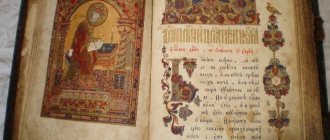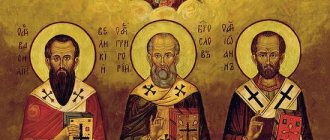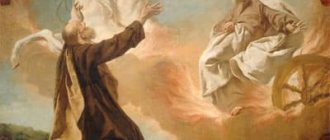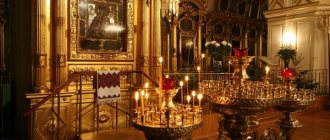Holy Fathers - who are they?
Holy fathers, or teachers of the Church, are those saints who, through their labors, formulated, founded, or helped establish any aspect of Church life.
These saints lived at different times, but each one was decisive for the Church in some way. Either during the period of church formation, or in an era of schisms and spiritual strife, or in the conditions of a “changing world” (in general or in a particular country). The Holy Fathers either set the foundations of the doctrine (as in the first centuries of Christianity), or rediscovered them anew - for their era.
At one time, the teachers of the Church laid the foundations of what now seems familiar to us: the course of divine services, the texts of prayers, monasticism as such, the composition of the books of the New Testament - the language itself...
In other words, these are saints, without whom the Church in its current form would not exist.
(Sometimes the term “holy fathers” is considered even more broadly - meaning by the teacher of the Church any saint (that is, a holy priest or bishop) and any reverend (that is, a holy monk), since each, to one degree or another, was also a father - teacher - even if only within the confines of his monastery).
Christian communities of the first centuries
To fully appreciate the feat of the holy fathers, you need to go back 1700 years, to the first centuries of Christianity - it was during that period that most of the saints lived, whom the Church classifies as teachers of the Church.
The Church then rested on tradition and the reverent memory of the Apostles, who, after the ascension of Christ, wandered the earth, gathered communities and passed on to them the fundamentals of the Christian faith. Sometimes these were communities in the literal sense: when people united in communes, they had everything in common and were all, in the full sense, brothers and sisters in Christ...
Twelve Apostles. Christian communities of the first centuries treasured their words and instructions especially carefully.
Apparently, there was no liturgical charter (that is, an approved and uniform course of services for all). And the services themselves were not some kind of event abstracted from everyday life, but a meeting of spiritual like-minded people. Every Sunday or on other significant days, people of the community met, prayed to Christ, prayed for everyone and everything, read the Holy Scriptures, sang prayers, and at the end received communion. Everyone in the community was united in the desire to be with Christ. Everyone lived from Sunday to Sunday, from Communion to Communion.
In that Church life, perhaps, there was not the structure that we are accustomed to now, but there was something else that saints and priests often set as an example - Church life is alive and devoid of any formality. Everything external was a complete reflection of the internal, and everything internal was the desire to be with Christ and find life in Eternity.
"teachers of the Church" (doctors ecclesiae)
Albertus Magnus, Alfonso Liguori, Anselm of Canterbury, Anthony of Padua, Bede the Venerable, Bernard of Clairvaux, Bonaventure, Cyril of Alexandria, Cyril of Jerusalem, Ephraim the Syrian, Francis de Sales, Hilary of Pictavia, Isidore of Seville, John of Damascus, Juan de la Cruz, Lawrence of Brindisia, Leo The Great, Peter Canisius, Peter Chrysologus, Peter Damiani, Roberto Bellarmino, Thomas Aquinas.
In 1970, Pope Paul VI awarded this title to women for the first time - Catherine of Siena and Teresa of Avila, and currently the total number of church teachers revered in the West has reached 32.
The feat of the holy fathers
Tradition, the spiritual zeal of the community and reverent memory did not protect the Church from the threat of heresies. “Heresy” in this case is not quite the right word, since most erroneous teachings about Christ arose at that time not out of intent and not out of a desire to split unity, but precisely because the Church had not yet formulated anything and all the truths were passed on from mouth to mouth. mouth.
It could be like this: a community or locality had its own elder - a bishop or just a priest. He could be extremely sensitive to the Christian tradition and, perhaps, be a real ascetic. But in his personal reasoning about this or that aspect of spiritual life he could be mistaken. His mistakes were listened to by others, and then also - with trepidation, as if they were the truth - they were passed on from mouth to mouth. And there was no one to correct it - because there was no telephone, newspapers or Internet. The interpretations became stronger and spread over ever larger territories.
And the more time passed since the death of the Apostles, and the more cultures and territories Christianity covered, the more the teachings of the communities could differ and the more “system-forming” issues it could concern. The most difficult differences were in the interpretation of the essence of the Trinity or Christ - since, from understanding this issue, the very structure of spiritual life and the reasons for many aspirations change. For example, some priests interpreted the essence of the Trinity in such a way that Christ is in the “literal” sense the son of God - that is, he was not with the Father from the beginning. Others interpreted the nature of Christ as primarily God, and calling human nature secondary. And so on.
From the 4th century, partly due to the fact that the Church ceased to be persecuted and became a state church in the Roman Empire (and partly due to the growing threats from heresies), church-wide Ecumenical Councils began to meet. At them, all controversial issues were brought to a single denominator, which were determined once and for all for all communities and all local Churches. And the works of the holy fathers either directly helped formulate doctrinal truths, or helped to clarify them as much as possible and thereby consolidate them for the future.
Patrology Lecture 1
Brief lecture notes
Patrology
- (from the Greek
"patir"
-
father
, and
"logos"
-
word
) - the doctrine of the Fathers of the Church.
The term was used in the Protestant environment by the scientist I. Gerhard. The term "patristic"
was also introduced by the Protestant Church.
Professor of patrol N.I. Sagarda tried to formulate the differences between these terms. Patrology studies not only the teachings, but also the life, works and all aspects of the teaching of the Church Fathers, and also considers its principles and methods of interpreting the Holy Scriptures. Patrology is divided into a biographical part (biography) and a bibliographical part (his works). Patristics - examines an aspect of the teachings of the Orthodox Church. For example, the doctrine of the Trinity is considered by various holy fathers, for example, Athanasius the Great, Tertulian, Basil the Great, etc.
The conditions for creating the text (context) are of great importance, i.e. What matters is the education of the holy father, social origin, place of residence, to whom he addresses, to whom he writes, etc.
DEFINITIONS:
Sacred Tradition
Sacred Tradition is what was passed down from ancestors to descendants. The source of tradition is God himself. Tradition is the revelation of God here on earth to you and me, the action of the Holy Spirit in our midst.
Oleg Davydenkov identifies three aspects: written sources, spiritual experience, and the mysterious life of the Church.
1. Written sources
— Holy Scripture (Bible), rules of the Apostles, rules of local and Ecumenical Councils, liturgical texts (prayers), works of the Holy Fathers, lives of saints, decrees of the Ecumenical Councils, Symbol of Faith.
2. Spiritual experience
- this is something transmitted to us on a spiritual level. This is the experience of communication of the Holy Fathers with God, which they convey to us in their writings and in oral traditions.
3. The Mysterious Life of the Church
- these are the Sacraments of the Church. This is the way we receive the Grace of God.
Church Fathers
“For although you have thousands of teachers in Christ, you have not many fathers; I have begotten you in Christ Jesus through the gospel.”
1st Epistle to the Corinthians of the Holy Apostle Paul
1 Cor. 4:15
“Words are products of the soul. Therefore we call those who instruct us fathers.”
Presbyter Clement of Alexandria (~150–~215)
Stromata. Book one
“For whoever is taught by anyone is called the son of a teacher, and this one is called his father.”
Holy Martyr Irenaeus of Lyons (~130–~202), Father of the Church
Refutation and refutation of false knowledge (Against heresies). Book four. Chapter XLI
The concept of the Holy Father can be identified with the teacher. This is the person following whose example his student acts, i.e. perceives his entire way of life. The student is in complete obedience to the teacher. Among church writers, the Fathers of the Church occupy a special place, because... achieved success in communicating with God.
Criteria defining the concept of “Fathers of the Church”: 1. Orthodoxy of the teachings of the Holy Father; 2. The sanctity of his life; 3. Recognition by the Church.
In the Catholic Church
They add one more criterion - it is
antiquity
.
According to Catholic theology, the patristic period ends with the 18th century (in the East it is St. John of Damascus, in the West it is St. Isidore). According to Orthodox theology
, the patristic period has no end; it continues to this day.
1. Orthodoxy of teaching.
The Holy Fathers expressed church teaching in all its pristine purity. Their works are the standard for the dogmatic and moral teaching of the church. The fathers tried to answer various questions of a dogmatic nature.
The dogma of the Holy Church was not formed in history, but was formulated
.
Christ in His Gospel expressed the whole truth in its entirety, and the Holy Fathers formulated these dogmas for their contemporaries. The patristic works are part of Divine revelation; they are the result of the joint action of God and man ( synergy
).
The works are not inspired by God, like the books of the Holy Scriptures. The job of the Holy Fathers was to interpret the Holy Scriptures
.
Principles of Interpretation of Holy Scripture:
1. Two axioms -
faith in the existence of God
, the second
- faith in the inspiration of the Holy Scriptures
; 2. Recognition of the divine-human character of Holy Scripture. The author is both God and man; 3. Recognition of the unity of all books of Holy Scripture. Books cannot contradict each other. All have a common goal - the center of scripture is Christ; 4. Combining the study of Holy Scripture and spiritual experience.
The concept of “private theological opinion”
.
The dogmas were revealed gradually.
Before the Ecumenical Council, the Holy Fathers could not accurately express themselves about this or that truth, so a precedent was created for error. For example, the doctrine of two-part human nature and three-part human nature, about the days of creation, about the origin of the world. 2. Sanctity of life.
According to the works of Patriarch Nektarios of Jerusalem, the following are recognized as evidence of holiness in people: 1. Impeccable Orthodoxy; 2. Performing all virtues; 3. God's manifestation of supernatural signs and wonders through one father or another.
Holiness and sinlessness cannot be identified. The Holy Fathers were not sinless, but they were successful in the fight against sin. Sanctity of life
is the implementation of the principle of combining the study of Holy Scripture with spiritual experience.
3. Recognition of the Church.
The recognition of the Holy Fathers was carried out mainly at Ecumenical and local councils.
The concept of “consent of the Fathers” (consensus patrum).
The range of questions includes all the main dogmas of the Church
: doctrine of the Trinity, doctrine of the face of Jesus Christ and His two natures, doctrine of the Holy Spirit, doctrine of the Church, doctrine of the Sacraments, doctrine of the last times.
The concept of "Teacher of the Church".
Teachers of the Church
all church writers are named who have put in a lot of work to reveal Orthodox theology for the interpretation of the Holy Scriptures. They are recognized as Blessed Augustine, Blessed Jerome, St. Photius the Patriarch of Constantinople, Blessed Theodoret of Cyrus, Blessed Theophylact of Bulgaria, Tertullian, Origen, Clement of Alexandria).
PERIODIZATION OF CHRISTIAN WRITING
Three periods:
1. Pre-Nicene period (before the First Ecumenical Council, (I - III centuries)).
2. The period of the Ecumenical Councils (IV - VIII centuries)
3. The period after the Ecumenical Councils (starting from the 9th century).
The following groups of Holy Fathers are distinguished in the periods: - apostolic men
(end of the 1st, beginning of the 2nd century).
This is the Hieromartyr Ignatius the God-Bearer, St. Clement of Rome, Hieromartyr Polycarp of Smyrna; - apologists
, i.e.
those who defended the Christian faith in the face of Roman power, pagan people, in the face of Jews; - anti-Gnostic
.
Geographical groups:
— Fathers
of the Alexandrian school
(Clement of Alexandria, Origen, St. Athanasius the Great, St. Cyril of Alexandria); — Fathers of the Antiochian school (St. John Chrysostom, Blessed Theodoret of Cyrus, St. Eustathius of Antioch); - Eastern Fathers who wrote in Semitic languages (St. Ephraim the Syrian, St. Isaac the Syrian); - Latin Fathers (Blessed Augustine, St. Ambrose of Medialan, Blessed Jerome of Stridon); — Mystic Fathers (St. Gregory Palamas, St. Maximus the Confessor, St. Simeon the New Theologian.
The Alexandrian and Antiochian schools differed in their view of the nature of the text of Holy Scripture. Alexandria School
considered
the allegorical method
of interpretation, and in some places used
the historical method
.
The School of Antioch
considered
a historical method
of interpretation, and some passages of Scripture could be understood
spiritually
.
The lecture notes were compiled by course participant
Marina Velikodneva
Why do we call the life of the holy fathers a feat?
They were pioneers. Navigating heroes and scientists who made great discoveries dealt with the visible world. The Holy Fathers wrote about invisible things. And through the Grace of the Holy Spirit, depths and such spiritual laws and truths were revealed to them that can only be revealed to a person through an exclusively holy life.
Mariners had a responsibility to themselves and their sailors. And the holy fathers determined the lives of millions of souls - and this responsibility is disproportionately great. That is why the Church considers their creations a feat.
Icon of the Holy Fathers of the Church.
Creations of the Holy Fathers
The Holy Fathers can be conditionally “divided” into two groups:
- The ascetic holy fathers - with their creations they described - each in their own way - the art of ascetic life. In essence, they explained and instructed how to achieve holiness and how to protect themselves in spiritual struggle. For example, Isaac the Syrian.
- The holy fathers-theologians , who with their creations finally formulated doctrinal truths and dogmas. We can say that we have finally defined the language of the Church. First of all, these are Basil the Great and Gregory the Theologian.
And here are some of the books that are most often mentioned as the creations of the holy fathers:
- “The Words” of Isaac the Syrian - many saints called this book a reference book for a monk - all aspects of spiritual life, spiritual laws and spiritual struggle are so deeply, accurately and correctly described in it;
- “The Ladder” of John Climacus: describes the path to holiness in the form of a ladder, where each new “step” is a departure from the world;
- “Soulful teachings” by Abba Dorotheus;
- The works of John Cassian the Roman are his works on the organization of monastic life. They formed the basis of many monastic regulations now adopted;
- The works of John Chrysostom are records of his sermons. They are considered to be the pinnacle of the ability to talk about complex things in relatively simple and understandable language;
- The book “The Invisible Take,” apparently written by Nikodim Svyatogorets, is another ascetic reference book;
- Creations of Ephraim the Syrian;
- Works of Peter Damascene;
- Works of Gregory the Theologian;
- Works of Basil the Great;
- The works of Gregory Palamas, dedicated to the doctrine of Divine energies and the Uncreated Light. This is one of the holy fathers who lived in the Middle Ages;
- The works of Simeon the New Theologian, another saint who lived in the Middle Ages.
For the most part, these are very difficult books to understand. An exception, perhaps, are the works of John Chrysostom, which are recommended for everyone to read, and the “soulful teachings” of Abba Dorotheus. And the rest, for example, the “words” of Isaac the Syrian or the “Ladder” of John Climacus, are best read with the blessing of a priest. Firstly, they are written in complex language. But the main thing is that they touch on such deep and serious aspects of spiritual life that they can be simply dangerous for a beginner. It's like climbing Everest without any physical training or adaptation to high mountain air.
Some books even concern only monasticism and are not applicable to worldly life.
Church Fathers and Their Works
Holy Fathers: the conciliar mind of the Church, a living understanding of the Word of God, a connecting link between the ancient texts of Revelation and today's reality. They give a person of any era the opportunity to perceive and make his own the faith that the Incarnate God brought to earth 2 thousand years ago.
The teaching of St. Fathers of the Eastern Church - it is true: it is the teaching of the Holy Spirit. I beg you, hold on to this teaching! It will guide you to a blissful eternity...
St. Ignatiy Brianchaninov
Creations of St. fathers - a treasury of two thousand years of experience of the Church. Their biographies and writings contain answers to any questions of church life. There is no area of doctrine that the fathers would not touch upon. They theologized and instructed, preached and consoled, composed liturgical texts and taught prayer, catechized the catechumens and denounced heretics. “There is no such problem of our confused times from which it is impossible to find a way out by carefully and humbly reading St. fathers,” writes Hieromonk Seraphim Rose.
Today we have free access to fatherly books. This great gift of God to our time should not go unclaimed.
The Science of Fathers
To a certain extent, a science called patrolology, which translated from Greek means “the word about the fathers,” can help to get to know the fathers (but does not replace reading primary sources). This is the science of the fathers and their creations. It is historical, as revealing the history of patristic writing, and theological, as giving an overview of patristic teaching.
The main subject of her attention is the holy fathers, and precisely those who left behind any monuments of church writing. At the same time, patrolology studies the life and writings of Christian authors who are not canonized, if their work influenced the development of church writing. They are usually called church writers and teachers, but not fathers. Whereas the Fathers of the Church can also be called church writers and teachers, since, undoubtedly, they are.
Who and why does the Church call “fathers”
In the Christian Church, since the time of the apostles, the title “father” has been adopted by outstanding spiritual leaders of believers (1 Cor. 4:15). According to the remark of Archbishop Philaret of Chernigov, one of the first Russian patrolologists, “they expressed that just as an ordinary son owes an ordinary father physical life, so a worthy student owes a worthy teacher the birth for a life worthy of a person, the formation of the highest powers of the soul...”
The Fathers of the Church are the mentors and teachers of Christ's Church. They are the chosen instruments of the Holy Spirit who instruct spiritual children in the revealed teaching and lead them to Christ, and therefore to salvation. The first fathers in this sense were St. the apostles, directly taught by the Lord Himself and under the special guidance of the Holy Spirit. Their teaching and instructions are an immutable law for the Church of Christ, and they themselves are called, unlike all other church leaders, messengers of Christ - apostles. The apostles are followed by the fathers themselves - the successors of the apostolic spirit.
The Fathers are distinguished by the Church itself from a number of other writers as persons who themselves assimilated and embodied Christ’s teaching in their lives and possessed the necessary properties to express it in their written works; they actively participated and continue to participate in the structure of the Church, in the establishment and dissemination of its teachings. To a certain extent, they are the culprits of the organization that the Church received, and the formulation of its teaching, in which it has reached our days, and therefore are rightly called the fathers of the Church. An essential characteristic of fathers is holiness of life. They are holy fathers.
Patristic tradition
The Holy Fathers are nothing more than the guardians of the Apostolic Tradition. All of them, like St. The apostles are only witnesses of the Truth - the God-man Christ. They tirelessly confess and preach it, they are “the all-golden lips of God the Word.”
St. Justin Popovich
Over time, after the Apostolic Tradition, the Tradition “properly paternal” appeared. It is understood as the writings of the fathers, which, although not dating back to apostolic antiquity, are nevertheless recognized as the truth of the Church. St. Athanasius the Great formulated three main conditions for the truth of the Father's Tradition: compliance with the Holy. Scripture; agreement with other fathers; good life and death in Christ by the author. If these conditions are met, the Church accepts this Tradition and recognizes for it the same dignity that belongs to the apostolic teaching.
The authority of St. fathers in the Orthodox Church is very high. "Listen to St. fathers as successors of St. apostles means listening to God Himself,” says St. Seraphim Sobolev. According to the blzh. Augustine, who departs “from the unanimous consent of the fathers, departs from the whole Church.” The consent of the fathers is due to the fact that they are all fellow members of the One Spirit.
Holy Fathers – Spirit Receivers and Spirit Bearers
In the Church, the best thinkers are St. fathers, for they think with the Holy Spirit.
St. Justin Popovich
On the day of Pentecost, the Holy Spirit descended on the apostles in the form of tongues of fire (Acts 2:1-47). Now it is poured out on believers in an invisible way through prayer, the sacred rites of the Church, especially through its Sacraments. Everyone receives the Spirit to the extent that they are able to receive and hold It. This measure is determined by faith and holiness of life. Therefore, only saints are true spirit-receivers and spirit-bearers. To them the Holy Spirit - the Spirit of wisdom and understanding - reveals the mysteries of God. They are the true and reliable interpreters of Divine Revelation.
Fathers and Divine Revelation
If the Word of Scripture is examined, then let it not be explained in any other way than as the luminaries and teachers of the Church have set forth in their writings...
From the Rules of the VI Ecumenical Council
The importance of following this rule for preserving the unity of faith and the Church is evidenced by St. Ambrose Optinsky. To the question: “Why does the doctrine of the Orthodox Church, planted by different apostles in different places and peoples, remain the same and unchanged for eighteen and a half centuries; The Lutheran teaching, taught by one person, was divided over the course of three centuries into more than seventy different parties - he answered: because the Catholic and Apostolic Church commands its children to understand the Holy Spirit. Scripture as...explained by God’s chosen men, purified from passions, God-bearing and Spirit-bearing...Luther allowed everyone...to interpret Scripture at their own discretion.”
Fathers and Ecumenical Councils
The Holy Fathers are recognized as the most reliable representatives of the Church in doctrine. The Ecumenical Councils, which met to affirm the true faith and overthrow heresy, always began with the reading of those patristic writings in which the issues to be considered were set out in particular detail. Relying on the patristic writings, the Council denounced heresy and pronounced a solemn confession of Orthodox teaching. Significant are the words that preceded the definition of the Council: “It has pleased the Holy Spirit and us...” - reflecting the “Theanthropic rule” of co-working between God and man.
The era of sainthood continues
To claim that St. there can be no more fathers means to claim that the Holy Spirit has left the Church.
Metropolitan Diokleian Callistus (Ware)
Orthodox patrolology claims that there are no time limits for holy fatherhood. Archbishop Philaret of Chernigov writes about it this way: “if any (limit) can be appointed, then only the one that ends the existence of the militant Church of Christ; There is no other limit and cannot be. The Holy Spirit always dwells in the Church... until the end of the world, the chosen instruments of the Spirit of God will appear in it for the needs of the Church.” Many examples confirm the truth of these words. Let's cite just two: St. Ignatius Brianchaninov (19th century, Russia) and St. Justin Popovich (20th century, Serbia) - remarkable ascetics: ascetics, writers, theologians; worthy representatives of St. recent fathers. Their works, written in full accordance with the teachings of St. fathers, is an integral part of the Holy Spirit. Traditions of the Universal Church. These fully apply to the words of St. Athanasius the Great: “Time makes no difference between our teachers - the oldest are not at all more important than the later: they are all equally fathers.”
The era of patrism continues and will last as long as the Church of Christ stands on earth and the Holy Spirit acts in it. In this Church - the Orthodox Church - it is preserved by the Holy Spirit through St. Fathers, the only way of salvation is the path of Christ, the apostles and St. fathers. This path is open to everyone. To follow it or not to follow it is a matter of personal choice and work of everyone.
Prepared by Lyudmila Kuznetsova
Patericon - what is it?
Separately, it is necessary to say about the Patericon - which can also be classified as patristic literature. These books—for example, the Great Patericon, the Palestinian Patericon, or “The Spiritual Meadow”—are a collection of short tales about the saints of the early Christian Church.
Sometimes it’s just one paragraph about some old man, sometimes it’s several stories about him. Some of the saints in these patericons are completely nameless, but all these stories are wonderful examples of holiness and Christian wisdom.
Some monasteries, including Russian ones, also have their own Patericon. For example, the patericon of the Holy Trinity Sergius Lavra, which describes the lives of all the saints who shone in this monastery. And of course - the Kiev-Pechersk Patericon, which contains the lives of hundreds of Kiev-Pechersk saints. Their lives spanned almost one century (!) and all their relics are now stored and open for worship in the caves of the Kiev-Pechersk Monastery.
How to read the Holy Fathers: end of quote
As you know, the favorite sport of the Orthodox is a duel using quotes, mainly from the holy fathers. The winner of the duel is the one whose quote was heard last. The words of messengers, confessors, interpreters, servants of Love are thrown like stones - without thinking about pain, or about mission, or about admonition. It's a sad picture.
Obviously, quoting is a misnomer. What then is right? Sometimes they say that an ordinary person does not dare to interpret Scripture, and the fathers will show and teach how to interpret Scripture correctly. True, it remains unclear how some texts will help interpret other texts - text to text, words to words. If I am not able to understand the text of the apostles, how can I understand the text of the successors of their work, interpreting their own - the apostles' - writings?
Answer: we need to read the fathers —themselves, and not those who tore their texts to pieces.
Let's demonstrate this principle with an example: let's read three quotes that clearly state one thing. Let us then read the text from which they are taken and understand that they assert something diametrically opposite.
1. “Slavery does not bring any harm, on the contrary, it brings benefit” - St. Ignatius (Brianchaninov)
So, everything is obvious: slavery is beneficial, writes St. Ignatius. He writes not just anywhere, but in an archpastoral letter regarding the abolition of serfdom. Defending slavery at a time when Russia was celebrating the liberation of the people is a strong move, isn’t it? It is not surprising that the saint’s appeal became a symbol of resistance to reforms coming from the very heart of the Church, resistance to the “party of revolution and disorder”
However, let’s read the text. If we put aside its immediate motive, we see a whole theology of power, domination and slavery - a revolutionary theology.
“The unfree state of people, which has many different forms, as should be known and understood by every educated person, is a consequence of the human descent into sin. The first power was declared to be that of the husband, and the first dependence was that of the wife. From this moment on, power is associated with violence, submission is associated with suffering.” For an apology for serfdom, this is a rather unexpected thesis: all power is the fruit of sin, there is power because there is sin . At the same time, the first inequality - gender inequality - is also a consequence of sin, it was also not intended by God (this reduction of political and social realities to issues of gender is remarkable: hello to Freudians and feminists). Read on.
“Relations of power and subordination collapse with the destruction of the world: then superiority and power will cease (1 Cor. 15; 24), then brotherhood, equality, freedom will be established, then the reason for the unity of power and subordination will not be fear, but love.” There will be no bosses and power, there will be freedom, equality and brotherhood - who is saying this: a terrible church reactionary or one of the leaders of the “party of revolution and disorder”? If the ideal of the Church is the elimination of power and slavery, the establishment of freedom, then what is the contradiction between the views of the Church and the revolution? Read on.
“In France, dreamers have more than once succeeded in captivating people in efforts to realize this dream, which can exist only in the imagination. What were the consequences? The consequences were torrents of blood, shaking the state with internal disorder. To get out of a difficult situation, the people had to restore power and authority... As long as humanity is subject to the influence of sin and passions, power and subordination are still necessary. They will certainly exist throughout the life of the world: they can only appear, are, will appear in various forms.” In other words, the mistake of the revolution is that it does not leave the circle of this world, it acts according to the logic of power , according to the logic of suffering and blood. The revolution is not radical enough! The justification of the state is exactly the same as that of the “liberal” Solovyov: the state exists not so that the Earth becomes Heaven, but so that it does not become hell. But what then, do nothing? Read on.
“This way of life (talking about serfdom) is outdated in moral and state relations.” If you can change the current situation for the better, you need to change it, but not fall into daydreaming. The main thing is this: “Civil slavery is a consequence of sin - sin in a broad sense, or that eternal death with which the human race was infected at its root, in the forefathers.” In general, the entire article is very sober, clear, and its main point is against daydreaming and frenzy.
I think this is how—and this is how—the “right degree” of radicalism is achieved. St. Ignatius is a critic much more fundamental than any political opposition: the whole world has fallen from the beginning, it is all an abomination. “Liberals” do not see this, they still count on peace, they are engaged by the authorities of this world. “The Savior of the world established His Kingdom on earth, but a spiritual Kingdom that can reside in any human society, no matter how this society is called by its civil structure - a monarchy, or a republic, or something else. Because the Kingdom of Christ, being not of this world (John 18:36), has nothing to do with the civil form of states.” The Church, the space of salvation, is outside the space of sin, power and slavery. The Church is a genuine revolution leading to the “life of the next century ,” where there will be neither masters nor slaves.
What do the words “slavery does not bring any harm, on the contrary, only benefit” mean? These words themselves belong to John Chrysostom, and Saint Ignatius cites them only to confirm his reasoning. Keeping all of the above in mind - the heavy burden of the power of the prince of this world, the circle of blood - we now understand what he means. True resistance to authority is a refusal to play their games. This is what Saint Ignatius says: “Use slavery through humility as a powerful means of salvation.”
2. “I want you to have an appeal to your husband, to obey him like the body to the head, and to joyfully recognize his dominance” - St. John Chrysostom
So, a woman must be subordinate to a man, and with joy. This is what Chrysostom states in his “Interpretation of the Book of Genesis.” However, let’s read the text.
“As if justifying himself before his wife, the man-loving God says: at first I created you of equal honor (to my husband) and wanted you, being of the same dignity (with him), to have communication with him in everything, and entrusted power over both the husband and you. by all creatures; but since you did not take advantage of equality as you should, for this I subordinate you to your husband.”
In other words, according to God's design, men and women are equal in honor and equal in rights. God wanted equal dignity between the sexes. Gender inequality is introduced along with all the consequences of the Fall: expulsion from Paradise, shame, death. To the extent that humanity is God, so much is woman free in it; To the extent that humanity is separated from God, so much is woman enslaved in it. And we see this in any nation, in any era - the enslavement of women, violence towards her, reducing her to cattle. This is the fallen world.
It has been noted more than once that in the Gospel the vast majority of “bad” characters are men. This is natural, because the world “not from which” His Kingdom is a world of male order, a world in the power of men. That is why there are so many women among His disciples. Isn’t the point of salvation to free humanity from the consequences of the Fall—including gender inequality? And we see this in the Gospel, and then in the entire history of the Christian world, the longing for the End of this world and the triumph of Heavenly Jerusalem. To the extent that the Church is “at home,” that is, holy, with God, to the extent that a woman is liberated, to the extent that her heavenly equality with a man is restored to her.
What then do Zalotust’s words about “joyful submission” mean? As we see, this is not a commandment for all times, but a simple statement of the actual situation in which a woman found herself after the Fall. And Christ comes to destroy this too - to destroy all the distortions generated by sin.
3. “The very place where the moon was at its creation, its size and brightness show that it was created in the form in which it appears on the fifteenth day” - Rev. Ephraim Sirin
So, everything is obvious: if the Monk Ephraim the Syrian, in his “Interpretation of the Book of Genesis,” considers it necessary to calculate at what point in its cycle the Moon was created and calculate its place in the sky, then, of course, the book of Genesis requires a literal interpretation. However, let’s read the text.
“I did not want to write this interpretation of the book of Genesis, so as not to repeat here again what has already been stated here in chants and conversations. But forced to do so by the love of my friends, I offer here briefly what I have proposed more extensively in chants and conversations” - so, Rev. Ephraim not only interpreted the book of Genesis in his “Commentary on Genesis.” Where else? For example, in the essay “On Paradise.” There we read:
“The tree was for him the image of a door, the fruit was a curtain that covered the temple. Adam picked the fruit, violated the commandment - and as soon as he saw the glory that shone with its rays from within, he ran away and hurried to seek refuge under humble fig trees.
He who planted the tree of knowledge placed it in the midst, so that it would separate both the high and the low, the holy and the Holy of Holies. Adam approached, dared to enter, and was horrified. Just as King Uzziah was covered with leprosy, so Adam exposed himself, and since he was stricken, like Uzziah, he hastened to leave. Both fled and hid, because both were ashamed of their flesh.
If all the trees of paradise were adorned with the same luminosity that clothed the glory, then just as the Cherubim cover their faces with their wings, so the trees would cover themselves with their branches so as not to look at their Lord. But they were all ashamed of Adam, who suddenly found himself naked, when the serpent stole his robe, and he himself lost his legs.
Since Adam was not allowed to enter the inner temple, this temple was guarded so that Adam would be content with serving in the outer temple, and as a priest serves, bringing a censer, so he would serve, keeping the commandment. The commandment for Adam was a censer, so that with it he could enter before the face of the Hidden One, into the hidden temple.
The mystery of paradise is depicted by Moses, who built two sanctuaries: the holy and the Holy of Holies. Access to the outer sanctuary was always free, but entry into the inner sanctuary was only allowed once. Thus, God closed the interior of paradise for Adam and opened the exterior, so that he could be content with the exterior.”
So, there is a certain secret here: not trees, but a temple, not a commandment, but a censer, and so on. Here, in the essay “On Paradise,” we obviously find an allegorical interpretation. In the Interpretation it is literal. Which one is correct? I don't know - obviously both. What significance do St. Ephraim’s discussions about the Moon have for our faith? I don't have an answer.
[When analyzing the texts of Ephraim the Syrian, we relied on the lecture of Protideacon Andrei Kuraev “What Adam and Eve Sinned”]
Saint Anthony - founder of monasticism
Saint Anthony lived in the 3rd–4th centuries in Egypt. He is called the founder of hermitage. Although, considering him exactly the “founder” is not entirely correct. Firstly, because many Christian communities of that time were essentially monasteries - with strict asceticism and reverence for virgin life. Secondly, because Saint Anthony was far from the first who left “from the world” into the desert. For example, the spiritual mentor of Anthony the Great was St. Paul of Thebes - who spent 90 of his 113 years in solitude.
However, Anthony the Great was the first to incite others to imitate his feat. He gathered around him a large number of like-minded people, and thanks to him, hermitage went from being an exceptional phenomenon to becoming, to some extent, widespread and outwardly formed. After him, monasticism was no longer just a way of life, but also a clearly defined external choice - leaving the world.
By the way, the founder of Russian monasticism also bore the name Anthony - this is the Venerable Anthony of Pechersk, who lived in the 10th–11th centuries.











